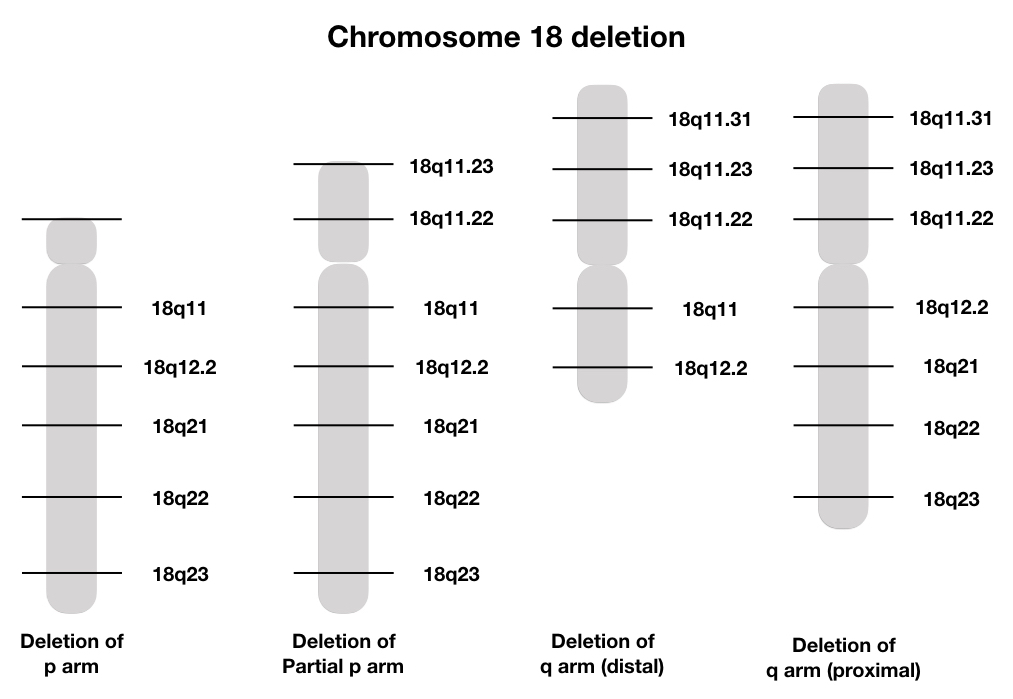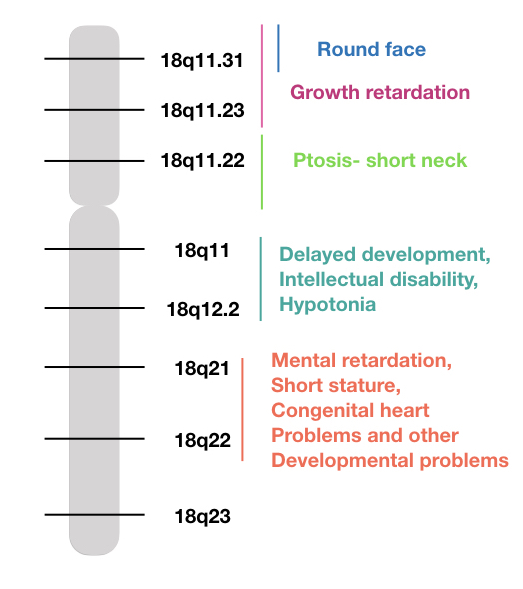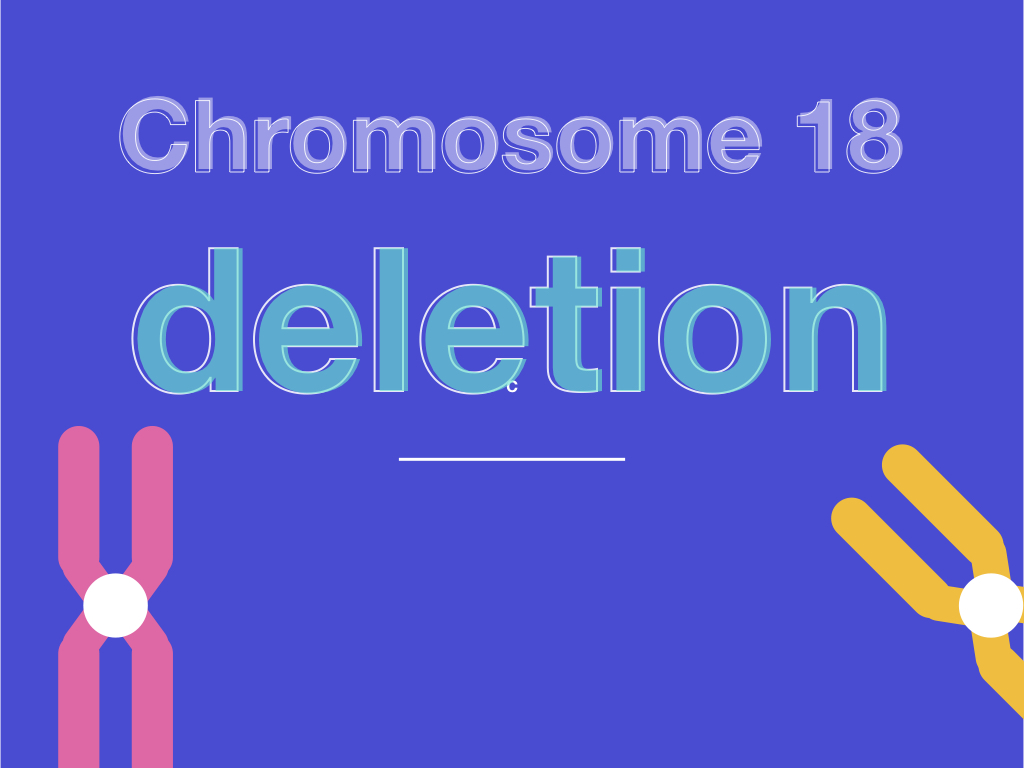Chromosome 18 deletion occurs when either of the p or q arms or its part or some fragment gets deletion from either copy. Some of the common deletions are chromosome 18p deletion, distal 18q deletion and proximal 18q deletion.
Chromosome 18 is a short submetacentric chromosome having 80Mb in size comprises a 2.5% portion of the total human genome. The common chromosome condition known as trisomy is associated with this chromosome.
Known as trisomy 18 or Edward’s syndrome is one of the congenital genetic conditions. Chromosome deletion is different from gene deletion in which a portion of chromosomes deleted, consists of a few 100 to 1000 or more genes or more than 1000MB chromosome portion.
While only a single gene or a part of a gene or few base pairs are deleted during gene or DNA deletion. So technically chromosomal deletions are more damaging than gene deletions.
Common chromosome 18 deletions are del18p, distal 18q deletion and proximal 18q deletion while some other associated with oncogenesis are Del(18)(p11), del(18)(q11q21) and del(18)(q21q21).
Here is the article on chromosome 18 deletion, common deletions of chromosome 18, symptoms and other related information.
Note that on this blog, articles illustrate information related to cytogenetic or karyotyping perspectives. We aren’t discussing any molecular genetic, gene or DNA level information here.
Related topic to read: The rarest case of 3p Mosaic Deletion Duplication Syndrome.
Let’s start the article:
What is chromosome 18 deletion?
When a portion of chromosome 18 from p or q arm or whole single gets deletion causing serious health issues, the condition is referred to as chromosome 18 deletion.
There are three common chromosome 18 deletion- 18p deletion, distal 18q deletion and proximal 18q deletion.
Chromosome 18p deletion:
When a portion of the p arm, whole p arm or copies of some genes from the p arm of chromosome 18 deleted, the present condition occurs.
The inheritance pattern of the 18p del, is not clear, however, balanced translocation is reported in either parent which might cause deletion later in the fetus. The condition occurs randomly, no known causative agent still reported.
The condition is congenital; cytologically written as 46, XX/XY -18p.

Symptoms:
Major signs and symptoms are associated with intellectual disability, developmental delay and several behavioral problems. However, the severity of symptoms depends on how much portions, which portions, how many genes and which genes are deleted from the p arm of chromosome 18.
Common symptoms are:
- Developmental delay
- Delayed speed and language
- Hypodontia
- Intellectual disability
- Problems with some common behavior
- Brachydactyly- short toes and fingers
- Abnormalities of antihelix
Interesting fact:
The condition is also referred to as Grouchy syndrome as it was first reported by Jean de Grouchy (French geneticist) in 1963.
18p- :
Yet another deletion condition in which the whole portion of the p arm of chromosome 18 delete is known as 18p-. Cytologically represented as 46, XX/XY, del(18p11).
Among all 18p deletions, 50% consist of deletion of the whole short p arm while in the rest of the 50% various regions of the p arm get deleted. 1 into 50,000 people may suffer from the present condition worldwide.
However, to date around 150 case studies are reported.
Symptoms:
- Mental retardation
- Speed and verbal problems
- Dysmorphic facial and other features
- Developmental delay and growth deficiency
- Dysplastic ears
- Mild to severe heart or brain malformations
Through the condition occurs randomly but familial imbalanced translocation and other chromosomal rearrangements may cause 18p deletion in the fetus. However, 80 to 90% of deletions occur de novo.
Read more: What is Chromosomal Translocation?- Definition, Mechanism and Types
Distal 18q deletion:
The distal chromosome 18q deletion occurs on the long q arm of the chromosome very nearer to the end. This means it happens on the end of the q arm and thus possibly includes satellite, telomeric DNA and some genes located near ends.
There are three types of genetic possibilities associated with this condition; either non-inherited inherited and de novo.
Most of the cases of distal 18q deletion are non-inherited and originated de no Novo, during a random event at meiotic cell division.
Although a few cases are inherited in an autosomal dominant fashion in which a single copy of a gene is sufficient to cause the disease.
Copies are inherited from unaffected parents or one of the parents. It may also transmit from affected parents however, the signs and symptoms of the disease are too mind in a parent or either parent.
In case, when it transmits from an unaffected parent, it shows a balanced translocation in the parent, and therefore, no symptoms appear. In balance translocation, no genetic material is gained or lost.
However, when it comes to the fetus or offspring, it causes unbalanced chromosome rearrangement such as deletion.
The distal 18q deletion affects 1 in 55,000 people worldwide. Cytogenetically, any portion of chromosome 8 gets deletion between the regions called 18q21 is considered distal 18q deletion.
Symptoms:
As we discussed the signs and symptoms of the present condition vary among patients. It depends on which and how much portion gets deleted. Some of the common symptoms are;
- Hypotonia- weak muscle tone
- Growth hormone deficiency
- Short stature
- Deep and wide-set eyes
- Midface hypoplasia
- Aural atresia- absent of ear canal
- Aural stenosis- hearing loss
- Vision problems, cleft palates
- Foot abnormalities
- Congenital heart defects
- Hypothyroidism
- Kidney dysfunction and related problems
- Dermal problems
- Genital abnormalities
- Dysmyelination
Besides other metabolic and developmental problems are also reported in the present condition. Neurological problems, cognitive disabilities and mental problems are also reported in serious conditions.
Seizure, intellectual disability, learning disability, developmental delay and depression and other conditions such as autism are also noted.
Noteworthy, when gene TCF4, present on the distal part of q arm delete, the condition is known as Pitt-Hopkins syndrome again results in a wide spectrum of intellectual disability and mental problems.
Proximal 18q deletion:
Another deletion opposite to distal deletion is the proximal chromosome 18q deletion. Here in this condition, copies or portions of chromosome 18 near the centromere are missing.
As copies are missing near the centromere, it is known as proximal deletion. The condition is even rarer than the proximal deletion as only 15 reported cases studied are present.
Statistically calculated, the frequency of proximal deletion 18q is 1 in 55,000 newborns.
The proximal 18q deletion occurs between the region 18q11.2 and 18q21.2. The symptoms and severity of the disease depends on how much portion between these two regions get deleted.
Much like other conditions, the present deletion occurs de novo. A random event during the mitotic cell division of egg or sperm causes proximal deletion syndrome. Nonetheless, some cases inherited autosomal dominant fashion.
Most of the cases are non-inherited and congenital.
Symptoms:
As we discussed, the proximal deletion condition is very rare and therefore symptoms-associated aren’t studied well. Some of the symptoms though are enlisted here:
- Abnormal development skills such as walking, running, crawling and talking.
- Delayed speed and vocab, difficulty in speaking
- Intellectual disability
- Hypotonia- week muscle tone
- Autism spectrum disorder
- Behavioral problems and other mental disabilities.
Besides these 4 major deletion syndrome on chromosome 18, some deletions are associated with cancer and tumor formation as well. Here are some;
del(18)(p11):
Del(18)(p11) is a deletion condition in which a part at p11 is missing, reported in* follicular lymphoma, Acute myeloid leukemia, myeloproliferative disorders and acute lymphoblastic leukemia.
Here tumor suppressor genes located between 18p11 and 18pter are mission, some of them are PPP4R1, PALBP1, L3MBTL4, LDLRAD4, EPB41L3 TGIF1, PEP161 etc.
Tumor suppressor genes actually regulate the activity of cell division (by negative regulation), which condition it causes depends on which genes get missing.
del(18)(q11q21):
This deletion occurs on the q arm of chromosome 18 anywhere and is reported in* medulloblastoma and primitive neuroectodermal tumor.
TCF4 and ROCK1 located at 18q21.2 and 18q11.1, respectively get deleted.
del(18)(q21q21):
It’s a type of proximal deletion likely reported in* meningioma in which genes such as IER3IP1 or HDHD2 may deletion and cause cancer.
* here we have indicated “reported in” which means the deletion isn’t directly linked with the condition or causes cancer every time, it is “reported” when cytogenetic investigations are done on various types of carcinoma samples.
Summary of the article:
Table for different type of chromosome 18 deletions, inheritance pattern and cause of it.
| Deletion | Inheritance | Cause |
| del18p | Not clear/ non-inherited | De novo/ balanced translocation from parents |
| del18p- | Not clear/ non-inherited | De novo/ imbalanced translocation |
| Distal 18qdeletion | Autosomal dominant/ non-inherited | De novo/ balanced translocation |
| Proximal 18q deletion | Autosomal dominant/ non-inherited | De novo/ balanced translocation |
| del(18)(p11) | Not clear | De novo |
| del(18)(q11q21) | Not clear | De novo |
| del(18)(q21q21) | Not clear | De novo |
Comparison between different chromosome 18 deletions and associated symptoms or disease.
| Deletion | Symptoms or disease |
| del18p | Developmental delay Delayed speed and language Hypodontia Intellectual disability Problems with some common behavior Brachydactyly- short toes and fingers Abnormalities of antihelix |
| del18p- | Mental retardationSpeed and verbal problems Dysmorphic facial and other features Developmental delay and growth deficiencyDysplastic earsMild to severe heart or brain malformations |
| Distal 18qdeletion | Hypotonia- weak muscle tone Growth hormone deficiency Short stature, Deep and wide-set eyes, Midface hypoplasia, Aural atresia- absent of ear canal, Aural stenosis- hearing loss, Vision problems, cleft palates, Foot abnormalities, Congenital heart defects, Hypothyroidism, Kidney dysfunction and related problems, Dermal problems, Genital abnormalities, Dysmyelination |
| Proximal 18q deletion | Abnormal development skills such as walking, running, crawling and talking. Delayed speed and vocab, difficulty in speaking Intellectual disability Hypotonia- week muscle toneAutism spectrum disorder Behavioral problems and other mental disabilities. |
| del(18)(p11) | follicular lymphoma, Acute myeloid leukemia, myeloproliferative disorders and acute lymphoblastic leukemia |
| del(18)(q11q21) | medulloblastoma and primitive neuroectodermal tumor |
| del(18)(q21q21) | meningioma |
Diagnosis of chromosome 18 deletion:
Commonly a technique known as prenatal genetic testing- fetal karyotyping is performed to rule out any chromosome defects. However, the doctor advises prenatal testing if it reports symptoms of developmental problems, defective facial features, family history of any genetic defect or disorder or presence of any birth defects.
The prenatal testing includes routine chromosome analysis of the fetus, not only chromosome 18 but also all chromosomes. It is performed by collecting chorionic villi samples or amniotic fluid- amniocentesis.
The samples are sent for conventional karyotyping or FISH or microarray analysis- advised by a doctor.
The life expectancy of chromosome 18 deletion:
As we discussed, there are many deletions on the p arm or q of chromosome 18, in fact in some cases the whole arm has been deleted. Therefore, phenotypic effects also differ.
The life expectancy of any chromosome 18 deletion depends on the severity of the condition, which means, how much portion or how many genes are deleted.
In addition to this, cases having present conditions are less, no clear evidence showing mortality rates are present. This clearly states that the life expectancy of chromosome 18 deletion patient depends on
- Severity of symptoms
- How much portion deletion
- Which important genes deleted
- The patient may have other problems or not.
Genotypic- phenotypic correlation map:
The genotypic-phenotypic correlation map shows the relation between the deleted fragment (deletion genes) and associated phenotypic variation. See the image below;
The only correlation map for chromosome 18 deletion was developed by Brenk et al.

Conclusion:
Chromosome 18 deletion is though not so common but associated with wide varieties of metabolic, developmental and mental conditions. Fetal karyotyping- a type of prenatal cytogenetic technique used to rule out deletion.
However, fore better results prefer to go for FISH or chromosome microarray.

